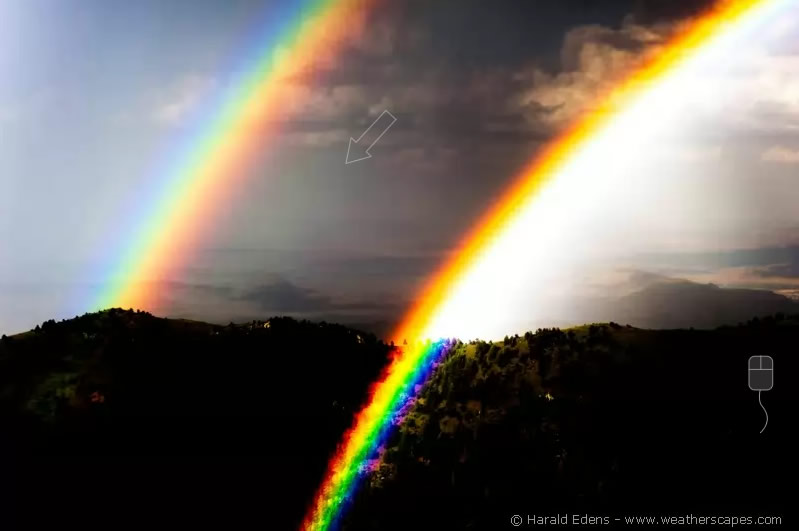|
|
|
|
| 5th Order Rainbow Discovery Image
The familiar primary and secondary rainbows have been known since there were eyes. The long sought 3rd and 4th order rainbows were finally imaged in 2011. Now we have the 5th order. Harald Edens photographed it on August 8, 2012. This is the first ever image on which the 5th order rainbow is positively identified. The version at left is considerably enhanced. Mouse over it to compare it with Harald's RAW camera image. The primary rainbow is at right. At far left is the outer secondary rainbow seen during strong showers when the primary is particularly intense. Between them is an area of dark sky, Alexanders dark band, where there is no primary or secondary rainbow light. There lies part of the fabled quinary or 5th order rainbow made by sunlight reflected five times inside raindrops. We see only its broad greens tending to blue towards the primary bow. Its yellows and reds are hidden behind the secondary bow. Harald took this from the Langmuir Laboratory for atmospheric research near the 10,800ft summit of South Baldy Peak, New Mexico, USA. Harald has now photographed the 5th order several times. He ascribes his success to the very bright rainbows formed locally from small thunderstorms and to the exceptionally clear high altitude low density air. Astute observation over many years by an atmospheric optics expert also helps somewhat! All images ©Harald Edens, shown with permission |
| Scientific Publication Harald's observations, analysis, discussion and conclusions will be fully published in February 2015: Harald E Edens 'Photographic observation of a natural fifth-order rainbow' Applied Optics, Vol. 54, Iss. 4, pp. B26–B34 (2015) |
| Before & After After his discovery, Harald searched back through his extensive image collection and also took post discovery pictures. Here are some examples showing traces of the 5th order bow. More are here. The RAW camera image is at left. The processing of the versions on the right is black and white point adjustment and then contrast, and exposure compensation. No increased colour saturation is needed. Adobe Lightroom 5.6 was used. |
| 5th and 6th order bows overlap the primary and secondary. The greens and blues of the 5th order lie in Alexander's dark band, the dark sky between the primary and secondary. |
This Bowsim ray tracing is an all sky view centred on the zenith. The sun is on the horizon at right. |
|
|
|
|

| About - Submit | Optics Picture of the Day | Galleries | Previous | Next | Today |
| A ray tracing calculation looking away from the sun. The view at right filters out the primary and secondary bows to reveal the far fainter higher orders. Below: An unfiltered simulation showing how the firth order is partly visible. Compare it with Harald's image. |
| The primary rainbow is produced by sunlight reflected once inside raindrops. Its outer red edge forms a circle ~42° radius centred on the antisolar point directly opposite the sun. The secondary bow from two internal reflections surrounds it. The 3rd and 4th order bows are towards the sun and since their discovery have now been photographed several times. Each successive higher order is fainter and broader than the lower ones. The increasing number of reflections take their toll. Rays forming higher orders skim ever closer to the drops' edge where the increasing angle of incidence produces greater and greater colour dispersion, thus broadening the bow. As the rainbow order increases, its observation gets more and more difficult. But, the dark sky between the primary and secondary presents a wonderful opportunity to see at least part of the 5th order rainbow fortuitously placed there. What next? The 6th order is lost in the light inside the primary bow. The 7th order could be next! |
| Three internal reflections produce the tertiary. |
 |